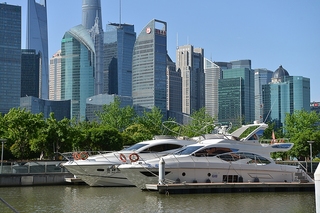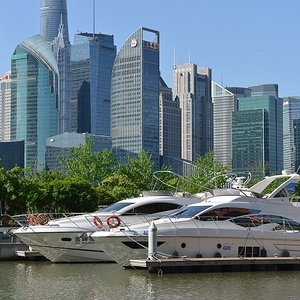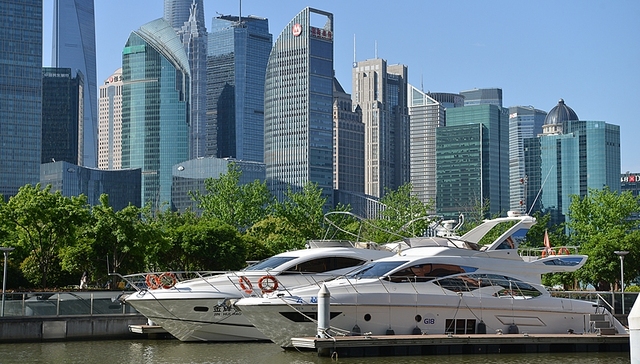by Yang Shuhongji
The once-niche yacht license is seeing a surge in popularity among Shanghai's younger professionals, raising expectations for a revival in China's long-stagnant yacht industry.
Zhang Sujie, a 29-year-old office worker and outdoor-enthusiast, recently spent 25,000 yuan (US$3,500) and completed 11 days of training to obtain an A1E yacht license, allowing him to operate motor yachts of any size. For Zhang, the certificate is not just a qualification — it's a ticket to the open seas.
"Since childhood, I've been fascinated by the ocean. Getting this license feels like opening a door to a new world," Zhang told Jiemian News, adding that he looks forward to renting a yacht with friends to explore the sea and get closer to nature.
Zhang is part of a growing wave of urbanites embracing marine leisure. According to the Shanghai Maritime Safety Administration, 373 yacht licenses were issued in 2024, up 40% year on year.
Yet while demand for personal yacht licenses rises, the broader industry faces steeper challenges. Shanghai currently has over 300 registered yachts, eight yacht marinas, and seven licensed yacht clubs. However, infrastructure remains limited, and yacht ownership costs — including maintenance, insurance, and docking fees — can run between 400,000 and 1 million yuan annually.

"The biggest bottleneck is still infrastructure," said Wang Kun, who heads a yacht training academy in Shanghai. He argues that building more marinas with full facilities is key to unlocking the industry's potential. “When modern marinas are in place, the whole ecosystem — from yacht manufacturing and training to high-end tourism and club-based social scenes — can grow.”
The lack of infrastructure has also constrained local yacht manufacturing. Shanghai Luck Yachts Manufacturing, which produces fiberglass fishing boats and luxury yachts, still relies heavily on overseas markets. "We receive three to four orders annually from abroad, with each yacht priced around 10 million yuan," said general manager Yuan Huifang.
Yet Yuan acknowledges that the export market is softening, forcing manufacturers to pivot toward the domestic market. "Domestic purchasing power remains limited because yacht prices are still high," Yuan said. To bridge the gap, Chinese yacht makers are shifting toward electric propulsion to reduce costs — mirroring the path taken by the electric vehicle industry. But Yuan remains cautious, noting that private orders are still rare and most domestic sales are institutional, not individual.
Efforts are underway to boost local demand. In December 2024, Shanghai launched the Yacht Industry Development Alliance in Hongkou's North Bund, uniting 23 industry stakeholders including yacht clubs, shipbuilders, and yacht owners. City authorities are also offering subsidies to help companies like Luck Yachts expand abroad while transitioning toward the domestic market.
Policy support has been consistent. Since 2009, yachts have been listed among China's encouraged industries, with local governments stepping up infrastructure investment. Today, there are 102 operational yacht marinas nationwide, with more under construction.
Industry insiders believe regulatory relaxation is also needed. "Reducing restrictions on yacht use is critical to making the market accessible to ordinary people," Yuan said, suggesting that with proper safety standards, yachting could move beyond an elite hobby.
Others agree that a more flexible regulatory framework could expand the consumer base. Shanghai Metropolitan Yacht Company's general manager Yu Wenzhe has publicly called for adjustments to navigation time restrictions, especially on the Huangpu River, to allow more customized and affordable yacht services.
At present, demand remains concentrated among affluent groups. Imported yachts typically cost from several million to tens of millions of yuan. Rental prices in Shanghai range from several thousand to over 10,000 yuan per hour, limiting broader adoption.
Still, there is optimism. Training programs are booming. Wang Kun's academy reports that over half of its May trainees were young white-collar workers. Shanghai remains one of the few cities in China offering A1 yacht licenses, which cover the largest motor yachts and require the highest level of proficiency.
The licensing process has also become more efficient. Following a regulatory overhaul in April 2024, Shanghai's Maritime Safety Administration introduced a new "test and issue" system that enables candidates to receive their licenses on the same day they pass the exam, cutting what was previously a 10-day wait.
According to China IRN, an industrial information platform, the domestic yacht market grew from 1.8 billion yuan in 2016 to 2.7 billion yuan in 2022, and is expected to exceed 20 billion yuan by 2025, outpacing global growth rates. Still, with only around 26,500 yachts registered nationwide — a fraction compared to Europe or the US — the market remains underdeveloped.
Wang remains confident that broader acceptance of yachting as a leisure activity, combined with improved infrastructure and falling prices, could make what was once a luxury pastime far more mainstream.





